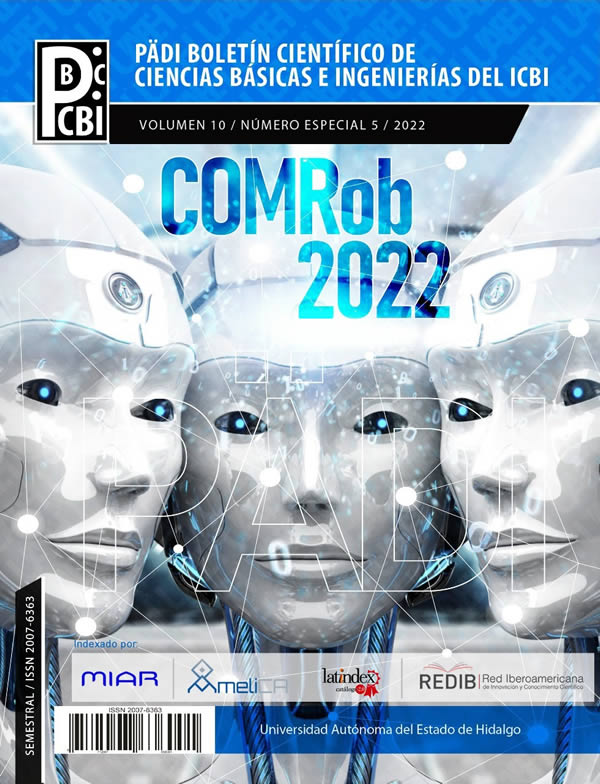Prototype for lower limb rehabilitation in hypotonic infants
Abstract
The development of a prototype for lower limb rehabilitation in patients with hypotonic syndrome of the newborn (SHRN) is described, using a parallel robot that simulates flexo-extension movements on hip, knee and ankle. The objective is to generate movement of the hip, knee, and ankle joints in the sagittal plane. The prototype built in 3D printing is presented to verify the tracking of trajectories for a basic movement therapy in the sagittal plane, validating the previously calculated kinematics, as well as the basic electronic system to give it movement and the control system to manipulate the aforementioned movements.
Downloads
References
Alfonso, I., Papazian, O., y Valencia, P. (2003). Hipotonía neonatal generalizada. Rev Neurol, 37(3):228 – 239.
Banacloche, B., Gomez, F., y Jadraque, R. (2015). Módulo neurología pediatrica. Servicio de Pediatría, Departamento de Salud Alicante. Hospital General, pp. 10 – 11.
Bionics, M. (2017). Atlas 2020 esoskeleton technical mannual. http://echord.eu/public/wpcontent/uploads/2018/01/D4. 3-User-Manual-EXOTrainer.pdf. Accesado 08-06-2020.
Bouri, M., Abdi, E., Bleuler, H., Reynard, F., y Deriaz, O. (2014). Lower limbs robotic rehabilitation case study with clinical trials. En New Trends in Medical and Service Robots, pp. 31–44. Springer.
Chaparro-Rico, B., Castillo-Castaneda, E., y Maldonado-Echegoyen, R. (2015). Design of a parallel mechanism for knee rehabilitation. En Multibody Mechatronic Systems, pp. 501–510. Springer.
Cooper, R. A., Dicianno, B. E., Brewer, B., LoPresti, E., Ding, D., Simpson, R., Grindle, G., y Wang, H. (2008). A perspective on intelligent devices and environments in medical rehabilitation. Medical Engineering & Physics,30(10):1387–1398.
de noticias ONU, C. (2016). Onu llama a poner fin al estigma contra las personas con s´ındrome de down. http://www.un.org/spanish/News/story.asp?newsID=25999#.V74EIfl97IV. Accesado 01-09-2020.
Essential, S. (2017). Manual de uso. https://www.ortoweb.com/media/useruploads/files/Manual_usuario_kinetec_spectra_essential.pdf. Accesado 30-06-2020.
Fenichel, G. (2009). Clinical pediatric neurology: a signs and symptoms approach, Chapter 6 - The hypotonic infant. Saunders/Elsevier, Philadelphia, PA, sixth edition edicion.
García, M., Lugo-Gonzalez, E., Arias-Montiel, M., y Tapia-Herrera, R. (2021). Kinematics of a robotic system for rehabilitation of lower members in hypotonic infants. En International Symposium on Multibody Systems and
Mechatronics, pp. 64–73. Springer.
Gherman, B., Birlescu, I., Plitea, N., Carbone, G., Tarnita, D., y Pisla, D. (2019). On the singularity-free workspace of a parallel robot for lower-limb rehabilitation. Proceedings of the Romanian Academy, 20(4):383–391.
Hocoma (2018). Movilizacion temprana y segura incluso en el cuidado agudo. https://assets.cdnma.com/16114/assets/Brochures_Flyer/
P_Erigo/fly_Erigo-ES_20180129_WEB.pdf. Accesado 01-06-2020. Krebs, H., , y Volpe, B. (2013). Rehabilitation robotics. Handbook of clinical neurology, 110:283–294.
Llorente, D. L. y Robles, C. K. (2014). Experiencia de la terapia con lokomat en pacientes portadores de paralisis cerebral y síndromes ataxicos, instituto de rehabilitacion infantil teletón concepción chile. Revista Médica Clínica
Las Condes, 25(2):249–254.
Martin, K., Kaltenmark, T., Lewallen, A., Smith, C., y Yoshida, A. (2007). Clinical characteristics of hypotonia: A survey of pediatric physical and occupational therapists. Pediatric Physical Therapy, 19(3):217–226.
Metrailler, P., Blanchard, V., Perrin, I., Brodard, R., Frischknecht, R., Schmitt, C., Fournier, J., Bouri, M., y Clavel, R. (2006). Improvement of rehabilitation possibilities with the motionmaker tm. En The First IEEE/RASEMBS International Conference on Biomedical Robotics and Biomechatronics, 2006. BioRob 2006., pp. 359–364. IEEE.
NOM-SSA, S. (1993). Control de la nutricion, crecimiento y desarrollo del nino y del adolescente. Criterios y procedimientos para la prestación de servicios.
Obinata, G., Fukada, S., Matsunaga, T., Iwami, T., Shimada, Y., Miyawaki, K., Hase, K., y Nakayama, A. (2007). Hybrid control of powered orthosis and functional neuromuscular stimulation for restoring gait. En 2007 29th Annual International Conference of the IEEE Engineering in Medicine and Biology Society, pp. 4879–4882. IEEE.
Schmitt, C. y Metrailler, P. (2004). The motion maker: a rehabilitation system combining an orthosis with closed-loop electrical muscle stimulation. En 8th Vienna international workshop on functional electrical stimulation, numero CONF, pp. 117–120.
Tsai, L.-W. (1999). Robot analysis: the mechanics of serial and parallel manipulators. John Wiley & Sons.
Vaida, C., Birlescu, I., Pisla, A., Ulinici, I.-M., Tarnita, D., Carbone, G., y Pisla, D. (2020). Systematic design of a parallel robotic system for lower limb rehabilitation. IEEE Access, 8:34522–34537.
Villamil (2020). Ejercitador de piernas para bebe con da ´ no cerebral. https://www.youtube.com/watch?v=TZGRiNjspD4. Accesado 10-08-2020.













